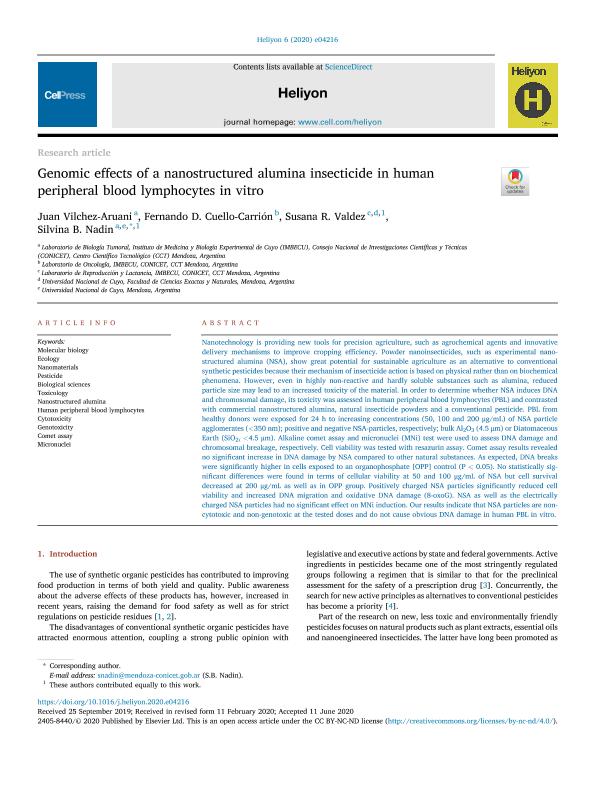Artículo
Genomic effects of a nanostructured alumina insecticide in human peripheral blood lymphocytes in vitro
Vilchez Aruani, Juan ; Cuello Carrión, Fernando Darío
; Cuello Carrión, Fernando Darío ; Valdez, Susana Ruth
; Valdez, Susana Ruth ; Nadin, Silvina Beatriz
; Nadin, Silvina Beatriz
 ; Cuello Carrión, Fernando Darío
; Cuello Carrión, Fernando Darío ; Valdez, Susana Ruth
; Valdez, Susana Ruth ; Nadin, Silvina Beatriz
; Nadin, Silvina Beatriz
Fecha de publicación:
06/2020
Editorial:
Elsevier
Revista:
Heliyon
ISSN:
2405-8440
Idioma:
Inglés
Tipo de recurso:
Artículo publicado
Clasificación temática:
Resumen
Nanotechnology is providing new tools for precision agriculture, such as agrochemical agents and innovative delivery mechanisms to improve cropping efficiency. Powder nanoinsecticides, such as experimental nanostructured alumina (NSA), show great potential for sustainable agriculture as an alternative to conventional synthetic pesticides because their mechanism of insecticide action is based on physical rather than on biochemical phenomena. However, even in highly non-reactive and hardly soluble substances such as alumina, reduced particle size may lead to an increased toxicity of the material. In order to determine whether NSA induces DNA and chromosomal damage, its toxicity was assessed in human peripheral blood lymphocytes (PBL) and contrasted with commercial nanostructured alumina, natural insecticide powders and a conventional pesticide. PBL from healthy donors were exposed for 24 h to increasing concentrations (50, 100 and 200 μg/mL) of NSA particle agglomerates (<350 nm); positive and negative NSA-particles, respectively; bulk Al2O3 (4.5 μm) or Diatomaceous Earth (SiO2, <4.5 μm). Alkaline comet assay and micronuclei (MNi) test were used to assess DNA damage and chromosomal breakage, respectively. Cell viability was tested with resazurin assay. Comet assay results revealed no significant increase in DNA damage by NSA compared to other natural substances. As expected, DNA breaks were significantly higher in cells exposed to an organophosphate [OPP] control (P < 0.05). No statistically significant differences were found in terms of cellular viability at 50 and 100 μg/mL of NSA but cell survival decreased at 200 μg/mL as well as in OPP group. Positively charged NSA particles significantly reduced cell viability and increased DNA migration and oxidative DNA damage (8-oxoG). NSA as well as the electrically charged NSA particles had no significant effect on MNi induction. Our results indicate that NSA particles are non-cytotoxic and non-genotoxic at the tested doses and do not cause obvious DNA damage in human PBL in vitro.
Archivos asociados
Licencia
Identificadores
Colecciones
Articulos(IMBECU)
Articulos de INST. DE MEDICINA Y BIO. EXP. DE CUYO
Articulos de INST. DE MEDICINA Y BIO. EXP. DE CUYO
Citación
Vilchez Aruani, Juan; Cuello Carrión, Fernando Darío; Valdez, Susana Ruth; Nadin, Silvina Beatriz; Genomic effects of a nanostructured alumina insecticide in human peripheral blood lymphocytes in vitro; Elsevier; Heliyon; 6; 6; 6-2020; 1-10
Compartir
Altmétricas



